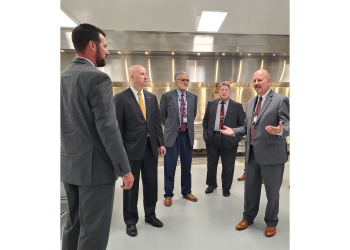Official opening hosted for Reception and Treatment Center
Official opening hosted for Reception and Treatment Center
FOR IMMEDIATE RELEASE (22-24)
CONTACT Laura Strimple, Chief of Staff
OFFICE 402-479-5713 | laura.strimple@nebraska.gov
May 18, 2022 (Lincoln, Neb.) – Today, Governor Pete Ricketts joined Scott R. Frakes, director of the Nebraska Department of Correctional Services (NDCS), agency leadership and invited guests for the official opening of the Reception and Treatment Center (RTC). The new facility designation represents the joining of the former Lincoln Correctional Center (LCC) and the Diagnostic and Evaluation Center (DEC).
As part of the construction project, the following areas have been added:
Staff and public access
Inmate intake and processing
Kitchen and dining
Staff administration and support
Visitation
Medical and behavioral health
“All of those areas represent new construction,” said Dir. Frakes. “Space allocated to the inmate population is larger than anything found in any of our other male, maximum security facilities. There is room to safely move around and congregate. There is natural light from above and windows with outdoor views.”
Governor Ricketts noted that combining spaces created operational efficiencies at the new facility and would ultimately lead to improved outcomes for the incarcerated men living there.
“The new Reception and Treatment Center is making Nebraska safer. It’s also an investment in the medical and behavioral health needs of our inmates. This facility will help our correctional system transition inmates back to society and maintain staff by providing a safer, better designed work environment,” said Gov. Ricketts.
In addition to adding operational space, new construction includes 64 beds (32 each) in the skilled nursing and behavioral health sections of the RTC.
“It has really become our Center of Excellence in how we manage a variety of health issues – not just in this facility, but across the agency,” said Dr. Harbans Deol, NDCS medical director.
“The clinic is unlike anything you will see inside a correctional setting or even the community. The combined space allows us to take a multi-disciplinary approach to addressing both medical and behavioral health needs. A variety of services will be available in close proximity like x-ray, laboratory, dental, and optometry. We can get results faster and provide a level of care that creates better outcomes for our patients,” added Dr. Deol.
Improvements and amenities made to staff areas will help with recruitment and retention. “It includes a workout center, men’s and women’s locker rooms, break areas, a staff dining room and training space,” said RTC Warden Taggart Boyd. “Those additions contribute to staff wellness. They now have space to work and relax, which was not available before.”
Improved sightlines and other security features will also enhance the safety of those working in the RTC.
“You cannot overlook the importance of the environment inside this facility,” said Dir. Frakes. “From the colors on the walls to the sound baffling, natural light and external views – all of this creates a healthier place for people to work and live.”
In addition to joining the former LCC and DEC, work has also been ongoing on what is the second phase of construction at the facility – the addition of 384 beds, scheduled to open at a later date.
“Those are maximum-security, general population beds designed for men who are among the most challenging in our correctional system,” said Dir. Frakes. “This will afford them the highest level of secure housing, with appropriate space to engage in programming and prosocial activities, the likes of which has not been available in our other maximum, male facilities.”
Funding has also been appropriated through the Legislature that will allow for the construction of 96 more beds that will address the needs of older men and those with developmental and cognitive needs. Bids will be solicited for that project through a request for proposal (RFP) process.
“Today’s opening represents another step forward in moving toward a modern correctional system that is not only functionally designed to provide higher security, but also addresses staffing and inmate needs in a way that was not considered even 20 years ago,” said Dir. Frakes.
“This truly helps us to fulfill the agency mission: Keep people safe.”
###



